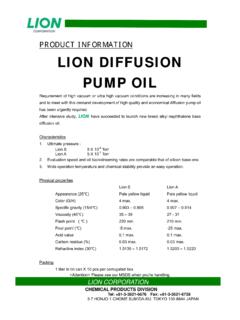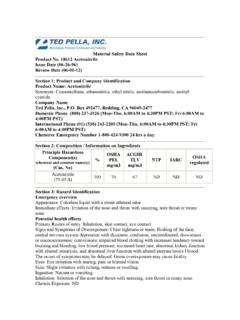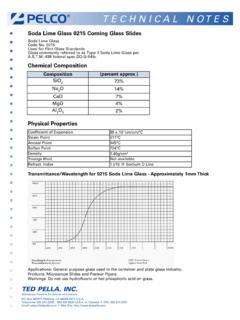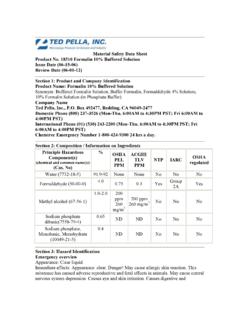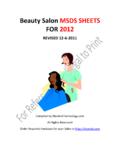Transcription of Material Safety Data Sheet Product No. 114-8, Black Nail ...
1 Material Safety data Sheet Product No. 114-8, Black nail polish Issue Date (04-11-05) Review Date (04-12-12) Section 1: Product and Company Identification Product Name: Black nail polish Synonym: nail lacquer Chemical Family: Nitrocellulose lacquer Company Name Ted Pella, Inc., Box 492477, Redding, CA 96049-2477 Domestic Phone (800) 237-3526 (Mon-Thu. 6:00AM to 4:30PM PST; Fri 6:00AM to 4:00PM PST) International Phone (01) (530) 243-2200 (Mon-Thu. 6:00AM to 4:30PM PST; Fri 6:00AM to 4:00PM PST) Chemtrec Emergency Number 1-800-424-9300 24 hrs a day.
2 Section 2: Composition / Information on Ingredients Principle Hazardous Component(s) (chemical and common name(s)) (Cas. No) % OSHA PEL mg/m3 ACGIH TLV mg/m3 NTP IARC OSHA regulated Ethyl Acetate (141 78 6) 40 50 400 ppm 400 ppm No No No N Butyl Acetate (123 86 4) 20 30 150 ppm 150 ppm No No No Nitrocellulose (9004 70 0) 5 10 NE NE No No No Isopropyl Alcohol (67 63 0) 1 5 400 ppm 400 ppm No No No N Butyl Alcohol (71 36 3) 1 5 100 ppm 100 pm No No No Camphor (DL) (76 22 2) 1 5 2 2 No No No Dibutyl Phthalate (84 74 2) < 5 5 No No No Section 3: Hazard Identification Emergency overview Appearance: Color viscous liquid.
3 Immediate effects: Irritation. Potential health effects Primary Routes of entry: Inhalation, skin and ingestion. Signs and Symptoms of Overexposure: Central nervous system depression. Eyes: May cause irritation. Skin: May cause irritation. Ingestion: May cause irritation of the digest tract. Inhalation: May cause irritation of the nose and throat. Chronic Exposure: Ingestion or inhalation of excessive quantities may cause nervous system depression ( , drowsiness, dizziness, kiss of coordination, and fatigue). Direct contact with this Material or exposure to the vapors or mists (greater than approximately 1000 ppm) may cause burning, tearing, redness, or swelling to the eyes and dry and cracking of the skin and dermatitis.
4 Chemical Listed As Carcinogen Or Potential Carcinogen: No ingredient present in this Product is identified as a carcinogen or probable carcinogen by NTP, IARC, or OSHA. See Toxicological Information (Section11) Potential environmental effects See Ecological Information (Section 12) Section 4: First Aid Measures If accidental overexposure is suspected Eye(s) Contact: Immediately flush eyes and obtain medical assistance if symptoms persist. Skin Contact: Wash with soap and plenty of water. Inhalation: Remove from exposure and treat symptomatically. Get medical attention if symptoms persist. Ingestion: Call a physician or poison control center immediately.
5 Induce vomiting as directed by medical personnel. Never give anything to by mouth to an unconscious person. Note to physician Treatment: ND Medical Conditions generally Aggravated by Exposure: Respiratory symptoms associated with pre existing lung disorders ( , asthma like conditions) may be aggravated by exposure to the vapors of this Material . Persons with pre existing skin disorder may be more susceptible to the effects of this Material . Section 5: Fire Fighting Measures Flash Point: 24 F Flammable Limits: Lower: Upper: 12 Auto ignition point: ND Fire Extinguishing Media: Water is the most effective fire extinguishing medium for Nitrocellulose.
6 Dry chemical, Carbon dioxide or universal type foam could be used to extinguish small fires. Special Fire Fighting Procedures: Wear self contained breathing apparatus and protective clothing to prevent contact with skin and eyes. Use water spray to keep fire exposed containers cool. Unusual Fire and Explosion Hazards: Vapors form an explosive mixture in air between and the upper and lower explosive limits which can be ignited by many ignition sources. Hazardous combustion products: Toxic fumes; carbon dioxide, carbon monoxide, and nitrogen oxide DOT Class: Flammable liquid. Section 6: Accidental Release Measures Steps to be taken in Case Material is Released or Spilled: Stay upwind and away from spill.
7 Keep all sources of ignition and hot metal surfaces away from spill. Keep out of drains, sewers, or waterways. Use sand or other inert Material to dam and contain spill. Do no flush with water; use absorbent pads. Large Spills: Call response team and notify appropriate local/state agencies. Waste Disposal Methods: Dispose of waste according to Federal, State and Local Regulations. Section 7: Handling and Storage Precautions to be Taken in Handling and Storage: Use non sparking tools when handling this Material . Keep containers tightly closed and store in a cool, dry area away from ignition sources. Storage temperature: NE Storage Pressure: NE Section 8: Exposure Controls / Personal Protection Engineering Controls Ventilation required: System should be designed to be able to maintain airborne concentrations below the established exposure limits.
8 If the current ventilation is not adequate to maintain this level, additional ventilation or exhaust systems may be required. Use explosive proof equipment. Personal Protection Equipment Respiratory protection: If airborne concentrations exceed the established exposure limit, a respirator is required. A self contained breathing apparatus equipped with the appropriate cartridges and canisters should be used and NIOSH approved. Protective gloves: Wear impermeable gloves. Skin protection: Impervious clothing. Eye protection: Safety goggles with side shields. Additional clothing and/or equipment: ND Exposure Guidelines See Composition/Information on Ingredients (Section2) Section 9 Physical and Chemical Properties Appearance and Physical State: Color viscous liquid.
9 Odor (threshold): Sweet ester. Specific Gravity (H2O=1): lb/gal Vapor Pressure (mm Hg): ND Vapor Density (air=1): ND Percent Volatile by volume: ND Evaporation Rate (butyl acetate=1): 1 Boiling Point: 171 F 228 F Freezing point / melting point: ND pH: NA Solubility in Water: Moderate Molecular Weight: NA Section 10: Stability and Reactivity Stability: Stable Conditions to Avoid: Open flame sources, electric spark, static, and heat. Materials to Avoid (Incompatibility): This Product is incompatible with strong acids or bases and oxidizers. Hazardous Decomposition Products: Thermal decomposition in the presence of air may yield carbon dioxide, carbon monoxide, and nitrogen oxide.
10 Under some conditions, methane, irritating aldehydes and carboxylic acids and hydrogen cyanide may be formed. Hazardous Polymerization: Will not occur. Section 11: Toxicological Information Results of component toxicity test performed: ND Human experience: ND This Product does not contain any compounds listed by NTP or IARC or regulated by OSHA as a carcinogen. Section 12: Ecological Information Ecological Information: ND Chemical Fate Information: ND Section 13 Disposal Considerations RCRA 40 CFR 261 Classification: NIF Federal, State and local laws governing disposal of materials can differ. Ensure proper disposal compliance with proper authorities before disposal.
